After we looked into cardiac arrests in sport injuries following Damar Hamlin’s cardiac arrest on Monday Night Football and other sport-related injuries, our team started exploring other football-related injuries. The CDC reports that over 20% of all emergency department visits for people aged 5-24 years old are for sports-related injuries and that football injuries account for the highest number of sport injuries (Rui et al., 2019).
Unfortunately, concussions are common within the National Football League (NFL); they report nearly 200 concussions occurred during pre-season and regular season for all years between 2015-2022 (NFL Player Health & Safety, 2023). Big hits and head injuries have prompted the NFL and the NFL Players Association to reassess protocols and enact changes to the concussion protocol (Sullivan, 2022). More work to decrease concussions is likely needed, as recent research showed that over 90% of former NFL players in a study were diagnosed with Chronic Traumatic Encephalopathy (McKee, 2023).
Football injuries and concussions are not specific to players within the NFL. In a study looking at college football players, more than 72% of concussions were sustained during practice, and nearly 50% were sustained during preseasons, even though preseason practices represents a much smaller amount of time (McCrea et al., 2021).
Acquiring large data sets that are diverse enough to compare between age groups and injury types is challenging due to disparate systems; however, because of the timely, representative data from across the entire US in Truveta Studio, we were able to study a subset of the US population to see what we could learn. We set out to describe the range of football injuries by demographics, where people present within the hospital (i.e., emergency department), and what part of their body were most affected by the injuries.
In high school aged boys (14-18-year-olds) we found over 10% of injuries requiring a hospital visit included a concussion or traumatic brain injury (TBI). Although other age groups had similar rates of concussions/TBIs amongst those who had injuries requiring hospital visits, the 14–18-year-old age group had the highest rate within those who had hospital visits.
Methods
We defined football-related injury encounters using a list of ICD-10 codes. Using a subset of Truveta data, we identified over 25,000 people with more than 32,000 football-related injury encounters.
We excluded a small set of injuries that were associated with multiple sports. We compared the demographics (i.e., age and sex) of those getting injured. We also looked at the location of the encounter to understand how people engaged with the healthcare system when injuries occurred.
Finally, we classified the body parts that were injured or affected during the football injury. We found the diagnostic codes that were associated with the same encounter as the injury and classified them into 13 categories according to injury location (cardiac/chest, concussion/TBI, face/head, groin, lower extremity, neck/back, pain in unspecified location, trunk, upper extremity, other location, unrelated to place of injury on the body). For this analysis, we excluded diagnoses that were classified as ‘other location’ or ‘unrelated to place of injury on the body.’
Results
Who made up the injured population?
It’s important to note that there may be differences between the percentage of people who are engaging in sports and those who are getting injured (Hanson et al., 2005; Harmon et al., 2018).
The population with football-related injuries were comprised of 92% males; less than 2,000 football injuries were reported from females. Within the male population, 81% of the injuries occurred for people under 18 years old (with the highest age group being males aged 14-18). We also see 10.4% of the male population was 18-25 years-old, and less than 4% of population was comprised of people over age 35.
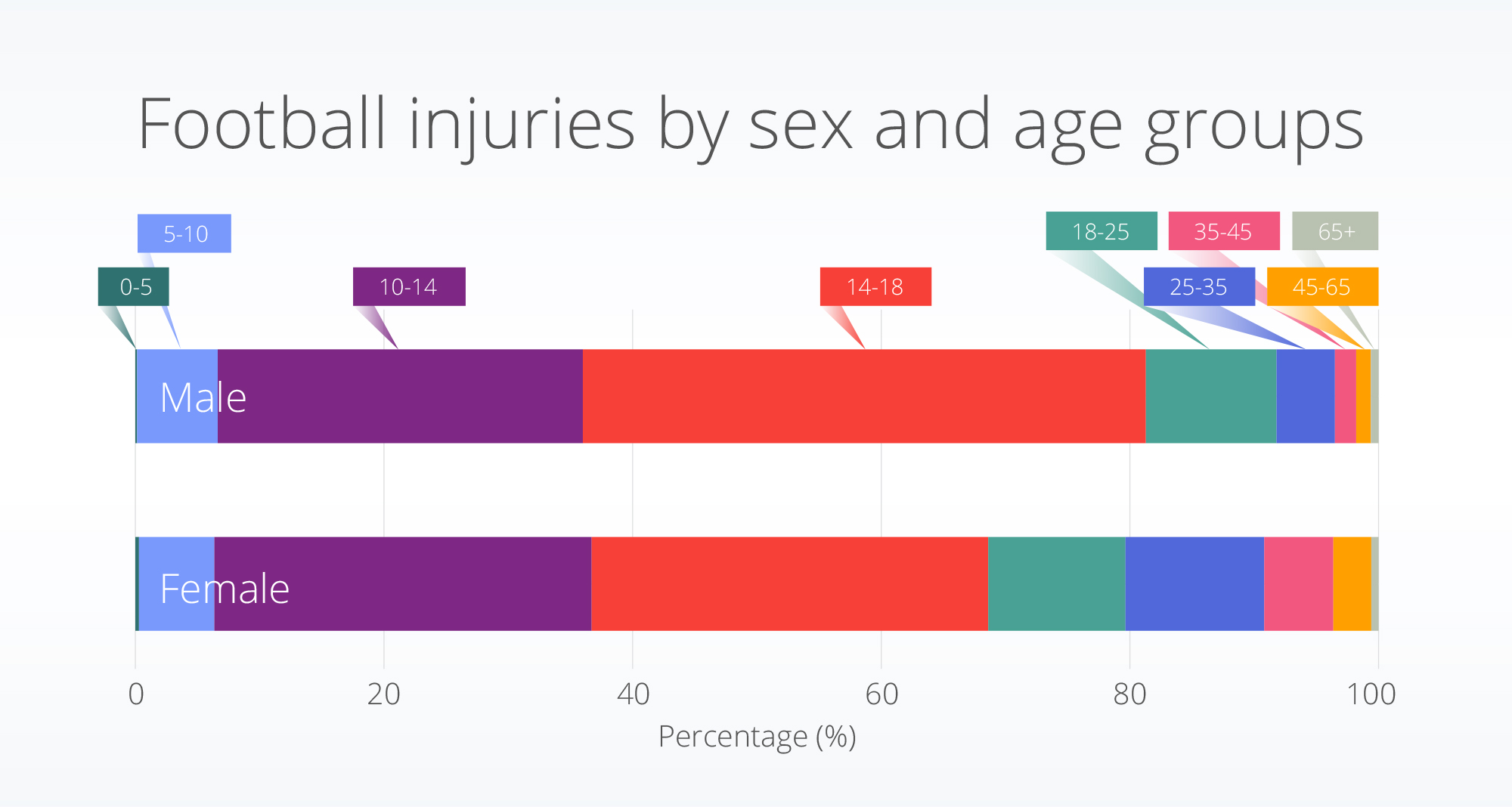
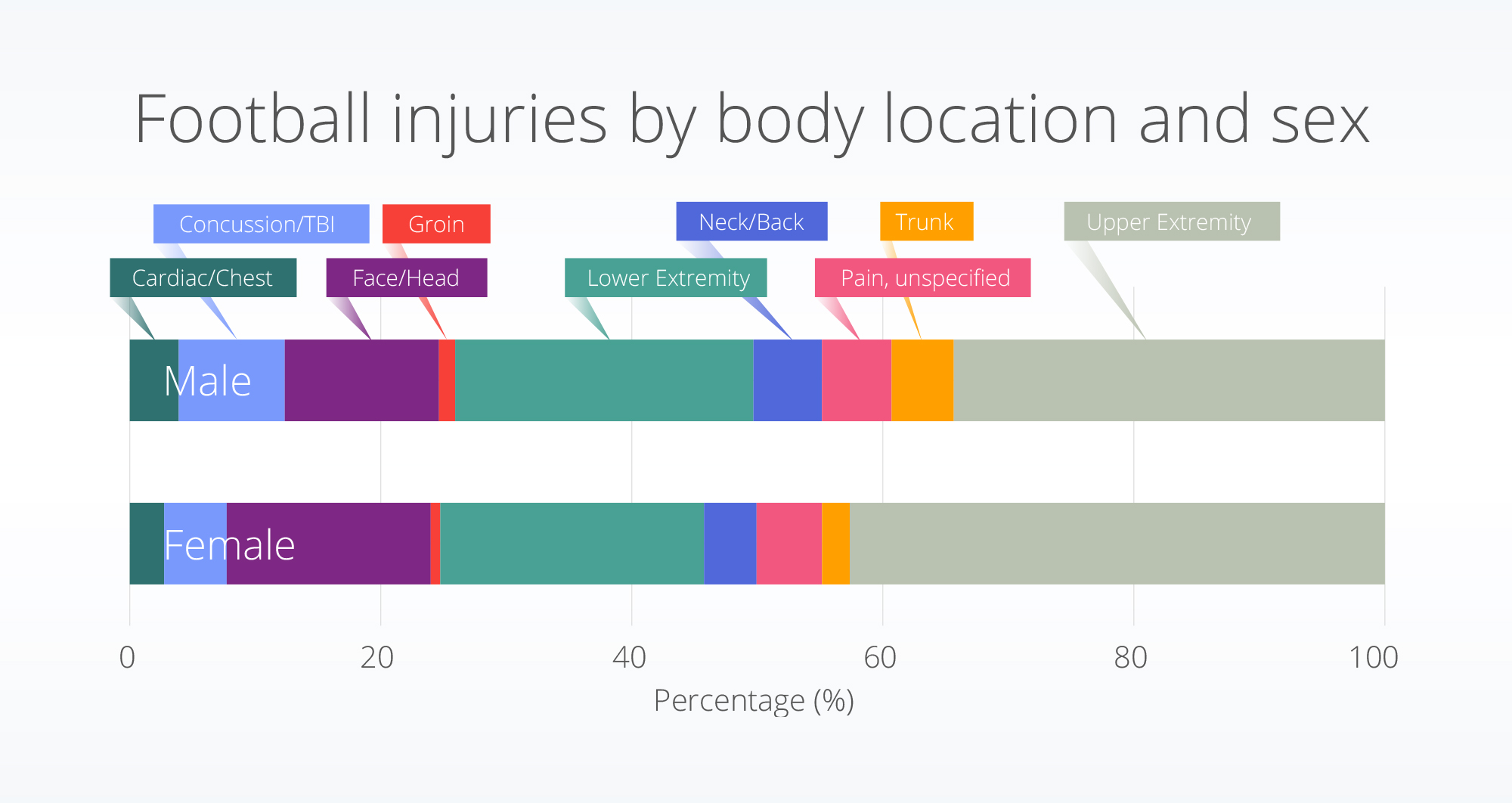
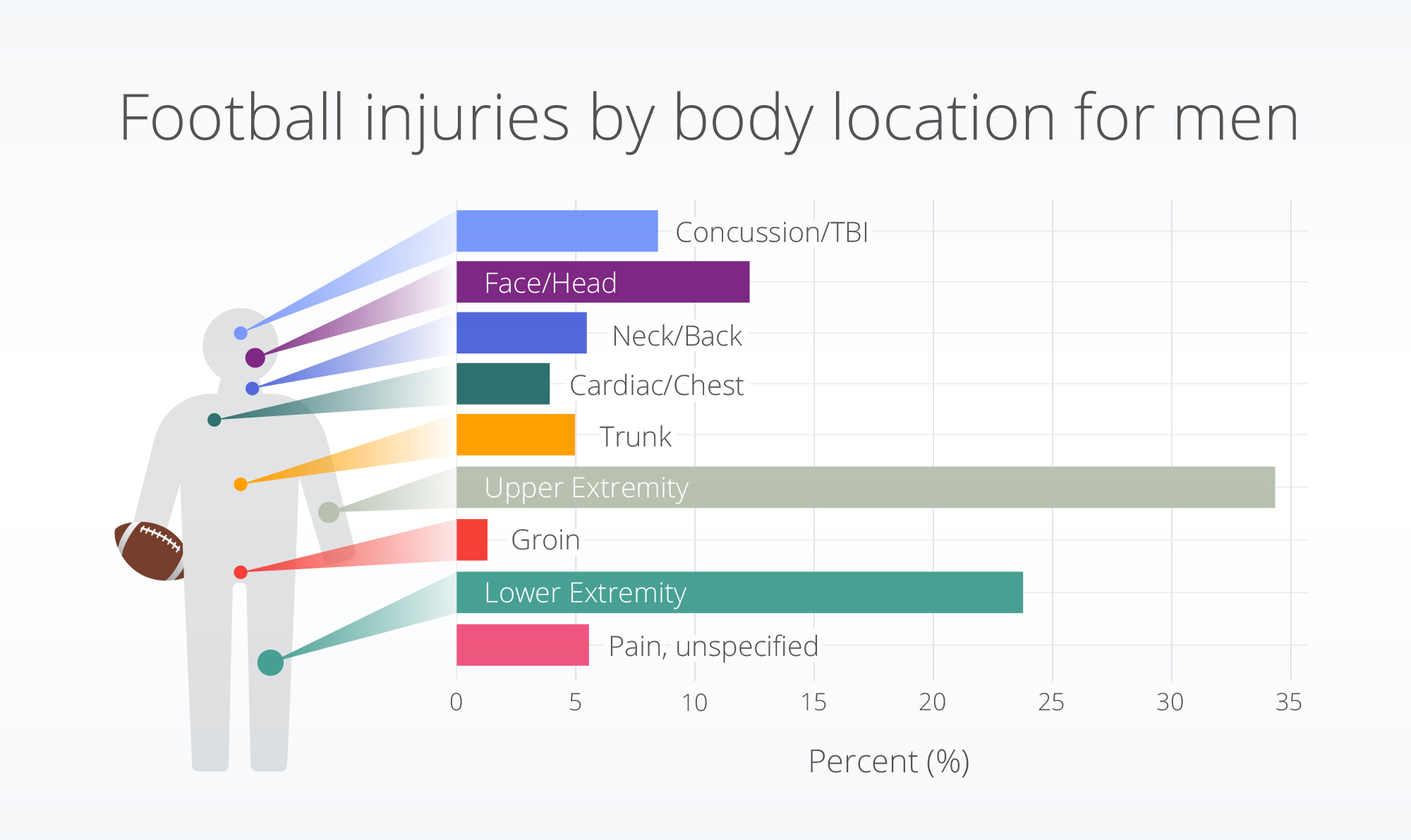
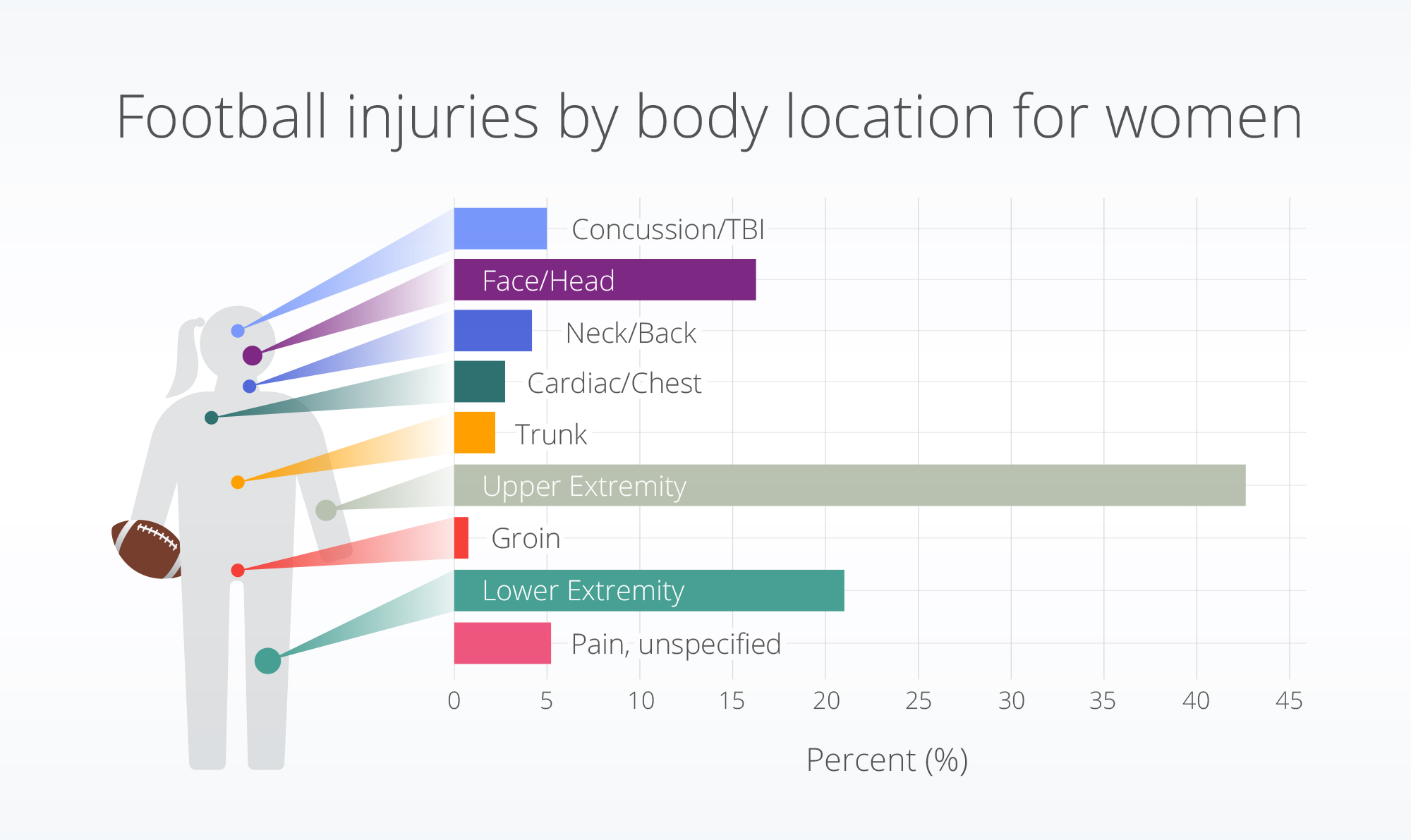
When people had football-related injures did they go to the emergency department?
Yes, as expected, most football injuries were emergency encounters (over 70% for all sex and age groups under 65). Inpatient encounters, indicating the need to be hospitalized, occurred more than 2% of the time for the entire population. Within the injured populations, the 18–24-year-old population had the highest rate of inpatient injuries (5.2%). Although a smaller population, the 65+ population experienced the lowest percent of emergency encounters; they had an increased rate of outpatient encounters.
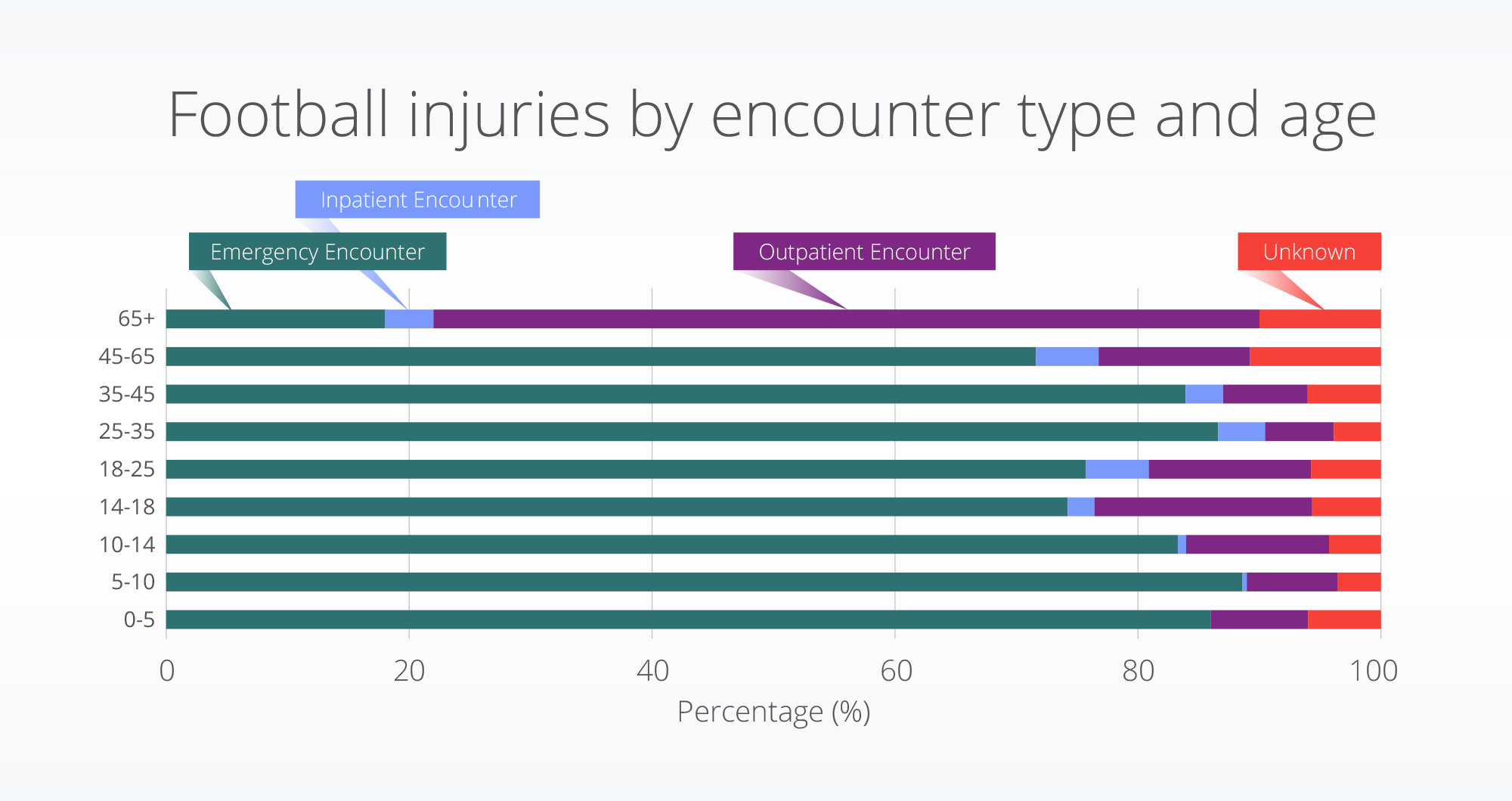
What body part is injured?
Of the body parts most affected, 8.2% of reported football-related injuries were concussion/TBI injuries. Across all age groups with football injuries, the 14–18-year-old population had the highest percent of concussions/TBI injuries (10.6%). Other age groups experiencing more than 5% of concussions/TBI injuries were the 10–14-year-olds (7.8%), 5–10-year-olds (7.4%) and 18-25 year-olds (5.9%).
Upper and lower extremity injuries made up 34.9% and 22.9% of overall injuries, respectively. The 65+ age group had the lowest percentage of upper extremity injuries (12.9%), and the 10-14 age group had the highest percentage of upper extremity injuries (42.0%). Lower extremity injuries had the highest rate within the 25–35-year-old age group (30.1%) and were lowest within the youngest (13.3%) and oldest age groups (11.5%).
Further, the oldest and youngest age populations had slightly different injury distribution patterns than the other age groups; the 65+ age group had the highest percent of cardiac/chest injuries and the 0–5-year-old population had the largest percent of face and head injuries.
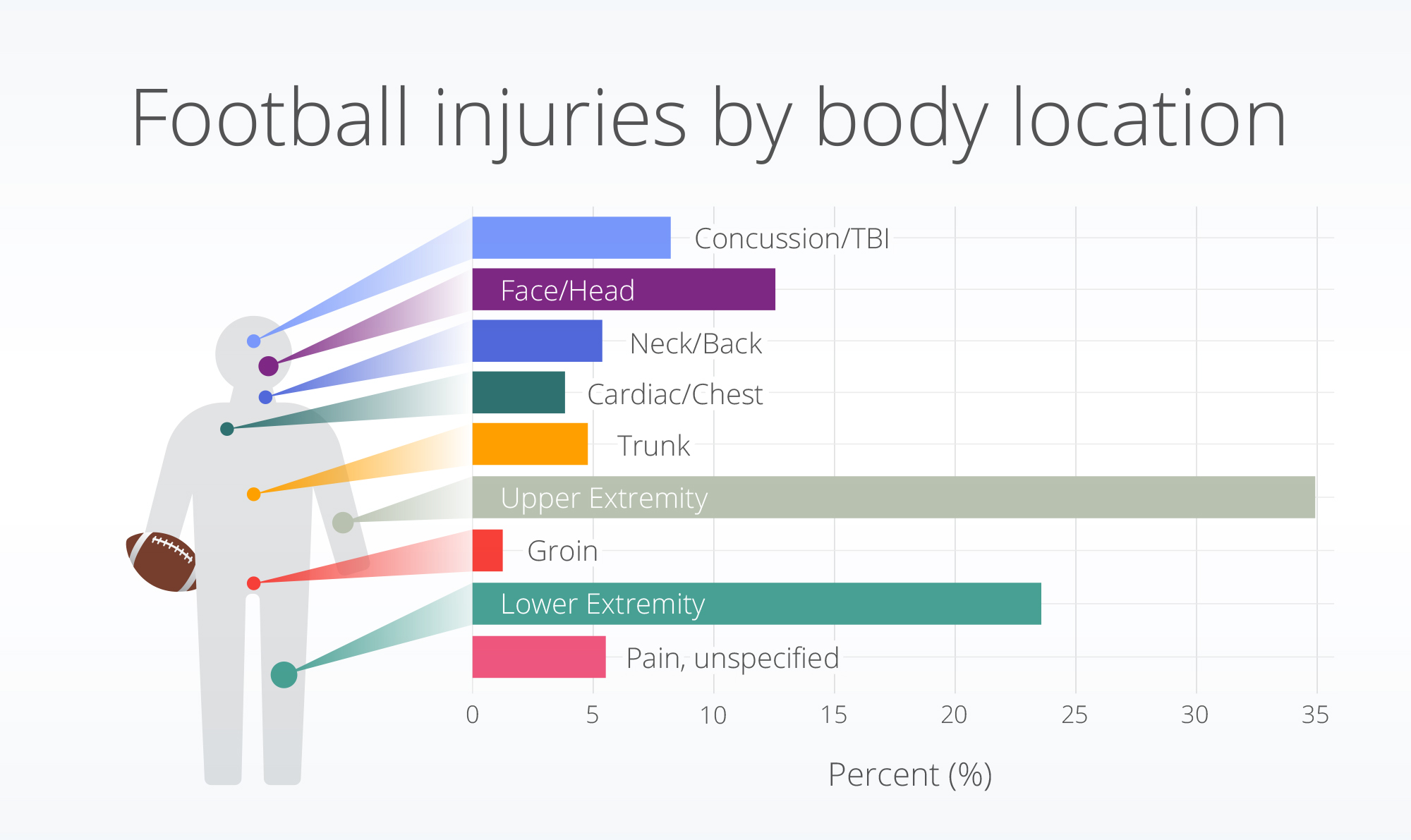
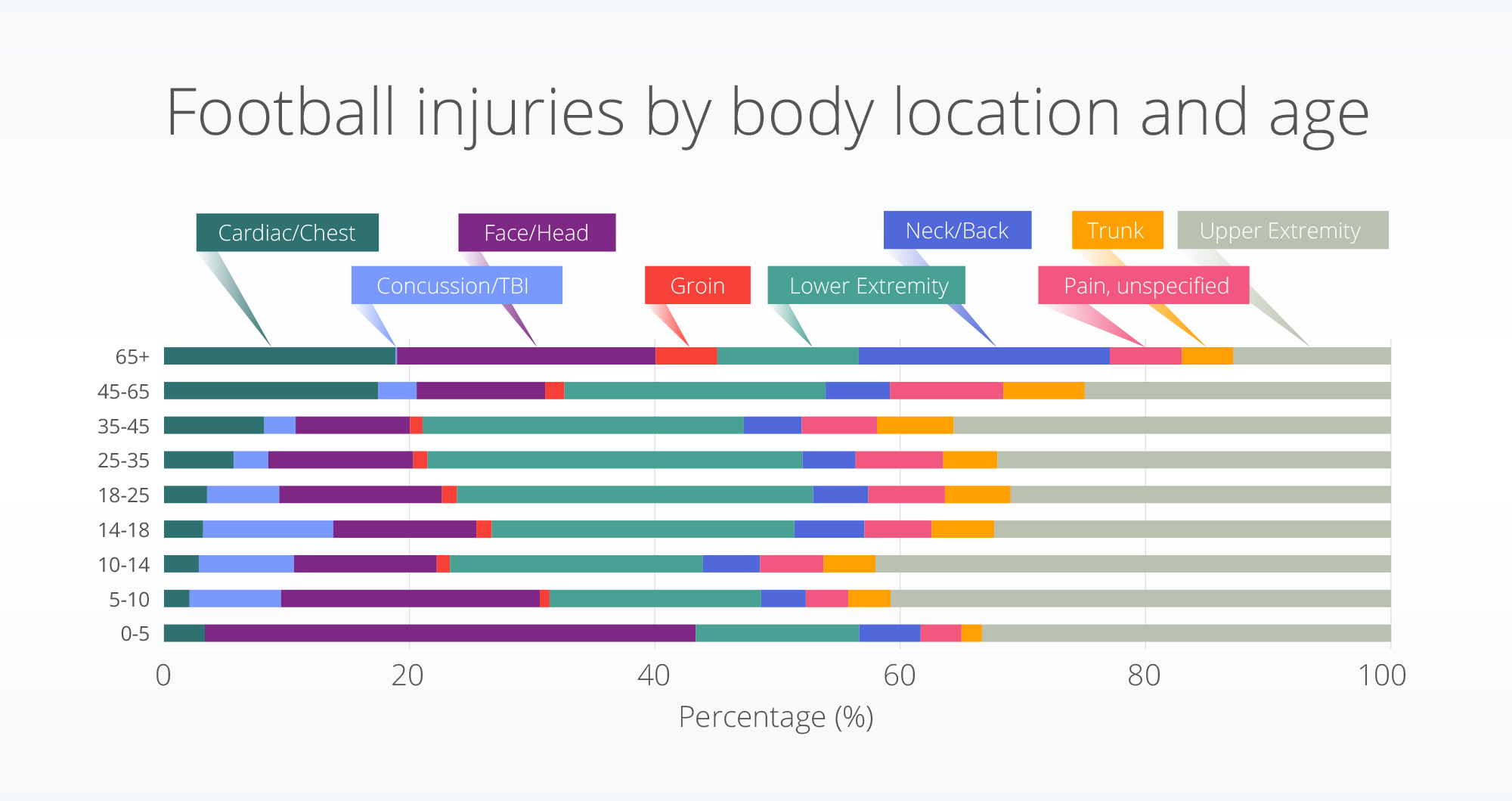
Discussion
In our population of people with football injuries, the percentage of concussion or TBI injuries were similar between 5-10- and 11–14-year-olds. However, previous research has shown children aged 5-7 have reported worse symptoms and preformed more poorly on clinical tests than children aged 11-13 (Brooks et al., 2017). This may suggest that although the rates of injuries are similar, the outcomes and time to recovery may be longer for the younger age group.
Within the high school-aged population, we saw the highest percent of concussions and TBIs. Previous research has suggested that for this age group, individuals who are symptomatic have reported school- or academic-related problems (Ransom et al., 2015). Additional research has shown that high school-aged males preformed worse on visual and verbal memory tests following concussions (Covassin et al., 2012).
Other research has shown that people over 75 have the highest rates of TBI-related hospitalizations and deaths (Centers for Disease Control and Prevention, 2022). Within these data, we see a low rate and count of football-related concussions for the population over age 65.
There are some limitations associated with this analysis. First, to be counted as a football-related injury, the person had to have an encounter within the hospital. Injuries that did not include a hospital visit would not be captured in our analysis. Further, multiple body parts could be included for one person/injury. To account for this, we counted each body part that was injured but did not look across different injury combinations. Additionally, we classified football-related injuries based on the existence of a subset of ICD-10 codes related to football. If a physician did not use these codes, the injury would not be captured within these data. Finally, no statistical analyses were conducted to test for differences between groups or account of the population who was playing football. In this study, we describe the differences within a population with football-related injuries, but additional research is needed to take into account the incidence amongst a population who plays football and test for significance.
This is our fourth blog investigating sport-related injuries. Although each sport has interesting trends, we were curious about what patterns might be similar or different across sports. Stay tuned for a future blog in which we start to compare injuries across different sports.
These are preliminary research findings and not peer reviewed. Data are constantly changing and updating. These findings are consistent with data pulled January 11, 2023.
References
Brooks, M. A., Snedden, T. R., Mixis, B., Hetzel, S., & McGuine, T. A. (2017). Establishing Baseline Normative Values for the Child Sport Concussion Assessment Tool. JAMA Pediatrics, 171(7), 670. https://doi.org/10.1001/jamapediatrics.2017.0592
Centers for Disease Control and Prevention. (2022, March 21). TBI Data.
Covassin, T., Elbin, R. J., Harris, W., Parker, T., & Kontos, A. (2012). The Role of Age and Sex in Symptoms, Neurocognitive Performance, and Postural Stability in Athletes After Concussion. The American Journal of Sports Medicine, 40(6), 1303–1312. https://doi.org/10.1177/0363546512444554
Hanson, D., Hanson, J., Vardon, P., McFarlane, K., Lloyd, J., Muller, R., & Durrheim, D. (2005). The injury iceberg: An ecological approach to planning sustainable community safety interventions. Health Promotion Journal of Australia, 16(1), 5–10. https://doi.org/10.1071/HE05005
Harmon, K. J., Proescholdbell, S. K., Register-Mihalik, J., Richardson, D. B., Waller, A. E., & Marshall, S. W. (2018). Characteristics of sports and recreation-related emergency department visits among school-age children and youth in North Carolina, 2010–2014. Injury Epidemiology, 5(1), 23. https://doi.org/10.1186/s40621-018-0152-0
McCrea, M. A., Shah, A., Duma, S., Rowson, S., Harezlak, J., McAllister, T. W., Broglio, S. P., Giza, C. C., Goldman, J., Cameron, K. L., Houston, M. N., McGinty, G., Jackson, J. C., Guskiewicz, K., Mihalik, J. P., Brooks, M. A., Pasquina, P., & Stemper, B. D. (2021). Opportunities for Prevention of Concussion and Repetitive Head Impact Exposure in College Football Players: A Concussion Assessment, Research, and Education (CARE) Consortium Study. JAMA Neurology, 78(3), 346. https://doi.org/10.1001/jamaneurol.2020.5193
McKee, A. (2023, February 8). New research from Boston University shows widespread brain damage in former NFL players. Boston University CTE Center. https://www.bu.edu/cte/2023/02/08/new-research-from-boston-university-shows-widespread-brain-damage-in-former-nfl-players/
NFL Player Health & Safety. (2023, February 3). Injury Data Since 2015. https://www.nfl.com/playerhealthandsafety/health-and-wellness/injury-data/injury-data
Ransom, D. M., Vaughan, C. G., Pratson, L., Sady, M. D., McGill, C. A., & Gioia, G. A. (2015). Academic Effects of Concussion in Children and Adolescents. Pediatrics, 135(6), 1043–1050. https://doi.org/10.1542/peds.2014-3434
Rui, P., Ashman, J. J., & Akinseye, A. (2019, November 15). Emergency Department Visits for Injuries Sustained During Sports and Recreational Activities by Patients Aged 5–24 Years, 2010–2016. National Health Statistics Reports; Centers for Disease Control and Prevention. https://www.cdc.gov/nchs/data/nhsr/nhsr133-508.pdf
Sullivan, B. (2022, October 13). Explaining the NFL’s latest concussion controversy and policy change. NPR. https://www.npr.org/2022/10/13/1128524103/nfl-concussion-latest
